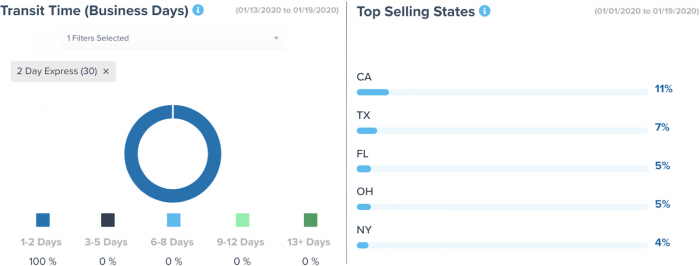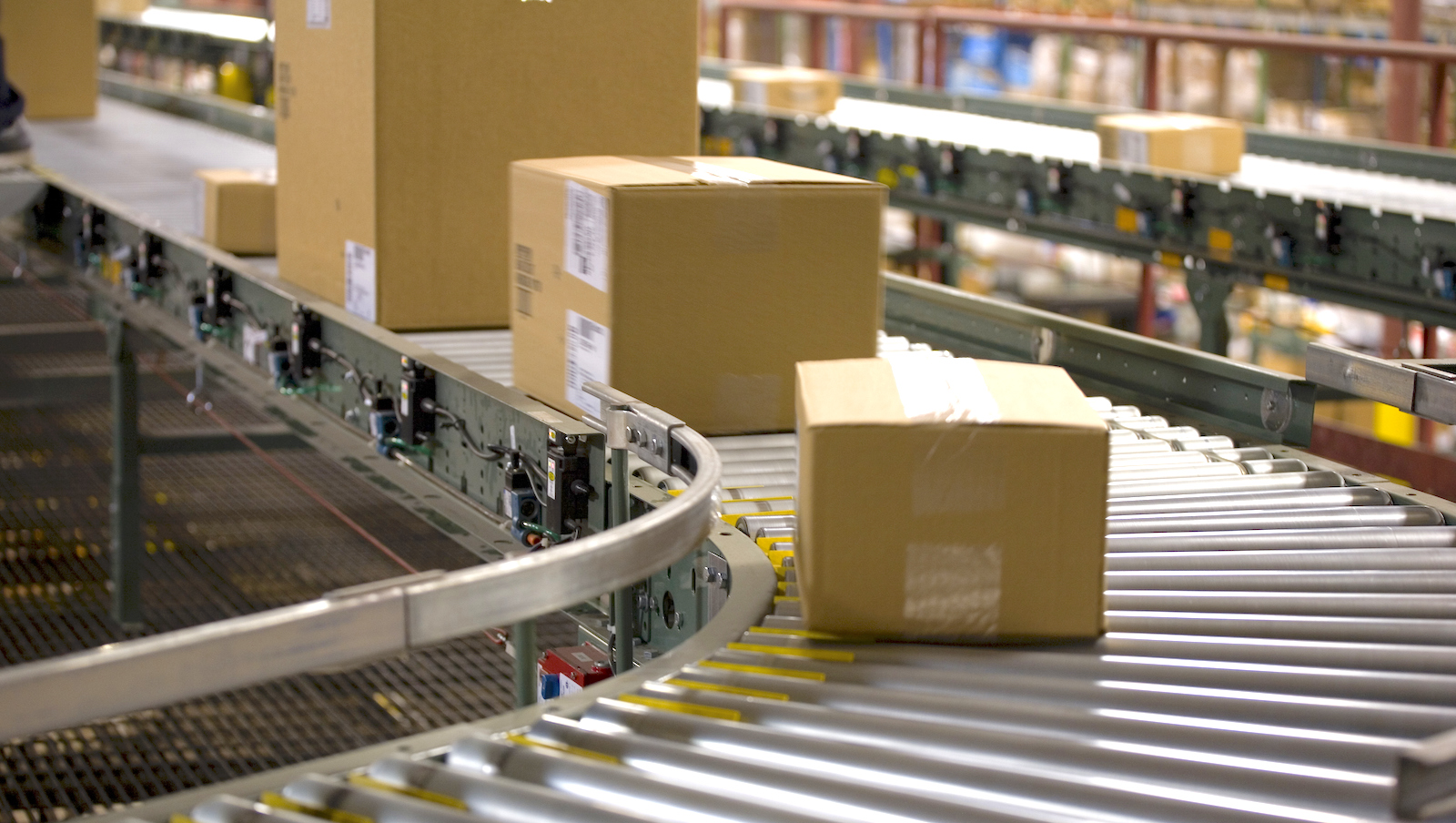Table of Contents
** Minutes
How automated shipping can speed up growth
4 ways to automate your ecommerce shipping
What do you want to learn?
Chatbots. OOO auto-email replies. Garage door openers. Online appointment scheduling software. Robotic vacuum cleaners. Driverless cars.
Automation is everywhere, with more forms of it popping up as technology continues to advance. At its core, automation simplifies tasks so that we have less work to do and/or can spend less time on repetitive actions. This ‘set it and forget it’ mentality is designed to make the mundane (you guessed it!), automatic.
One example of automation in ecommerce logistics is automated shipping.
As an ecommerce business grows, automating certain processes helps companies scale to meet the growing needs of their customers. Small ecommerce businesses can get away with certain manual processes because there’s not a very high order volume yet. At the same time, automating as much as possible early on can help businesses grow faster. There might be a higher upfront cost, but it can pay dividends.
If implemented properly, automated shipping can help you run your business with greater supply chain efficiency, saving valuable time and resources. Below we jump into how you do just that.
What is automated shipping?
Automated shipping is the automation of commercial shipping procedures as new orders are placed, including picking items from inventory, packing boxes, and getting packages in transit to be delivered to customers.
In the world of fulfilment, speed will get you in the lead. The purpose of an automated shipping solution is to automatically get orders that need to be fulfiled in a queue and eliminate some of the manual tasks involved. It can be as fancy as introducing the use of robots, or as simple as adding a layer of software or installing infrastructure like conveyor belts.
How automated shipping can speed up growth
Automated shipping operations encourage greater efficiency, leading to greater productivity. This means companies can fulfil a greater number of orders and/or have them processed faster. Thus, automated shipping helps optimise your supply chain. Let’s take a look at the particular benefits that businesses can enjoy by implementing automated shipping.
Repurpose resources
Automation significantly reduces the need for human intervention in shipping processes. This is because tasks like order verification and shipping label creation and printing can be performed using automation tools. As a result, business owners need less labour and can reassign team members to roles that should not rely on automation.
“An hour after an influencer ordered from me, he had already received an email saying his order had shipped. If I was fulfiling orders myself, it would have taken me much longer. This was the perfect example of ShipBob working how it should, automatically sending tracking info and giving my customers everything they needed.”
Tracey Wallace, Founder of Doris Sleep
Automated shipping can deliver massive benefits for ecommerce businesses that are processing hundreds of orders or more per month. By outsourcing fulfilment to a tech-enabled 3PL, ecommerce businesses can take managing inventory, packing boxes, dealing with couriers, and more off their plates.
Spend less money
Since autonomous shipping reduces the amount of manpower required, it naturally means that business owners can spend less time on tasks that anyone can do and double down on the most important tasks that only they can perform. While it may seem counterintuitive to pay someone else to do something that you can do for ‘free,’ it turns out that handling shipping yourself has many hidden costs.
The table below is an example from ShipBob customer Teri Miyahira’s blog post, “Why Moving Away from Self-Fulfilment Was My Smartest Business Decision to Date.” In it, she breaks down the tasks she was completing into categories by dollar amount. While the exact dollar amounts may differ for your business, this exercise helps show the real value of an entrepreneur’s time.
| $10/hour | $100/hour | $1,000/hour | $10,000/hour |
|---|---|---|---|
| Warehousing and inventory management | Talking to qualified leads | Negotiating with qualified leads/prospects (especially for B2B ecommerce) | Creating new products/services |
| Order fulfilment and packaging | Helping an existing client | Creating marketing campaigns | Expanding to new markets/locations |
| Post office and running errands | Drafting emails to leads and customers | Writing sales copy | Negotiating major deals |
| Customer service | Graphics and video editing | Creating split tests | Drafting brand messaging or positioning |
| Organising, cleaning | Fixing website | Planning a new sales funnel | Final decision in hiring team members |
| Basic market research | Cost analysis | Scouting for new team member talent | Forward vision thinking and long-term goal setting |
| Ordering supplies | Content creation (writing blog posts or on social media) |
Time is money. Every hour spent completing a $10/hour task instead of a $10,000/hour task, you are effectively losing $9,990/hour in revenue-generating activities. By delegating the low-dollar tasks, you can focus on the higher-dollar tasks that generate a positive ROI and help scale your business much quicker.
“It felt like all I did was eat, sleep, and pack orders. We couldn’t fit another person in my garage. I had to make a transition in order to scale. Since working with ShipBob, we’ve grown 115% and experienced 2.5 times more order volume. It was kind of like magic — my orders were imported into ShipBob from my Shopify Plus site and started getting fulfiled right away. I didn’t have to do anything.”
Noel Churchill, Owner and CEO of Rainbow OPTX
Improve efficiency
Simply put, automated shipping systems allow for significantly faster turnarounds. Since many time-consuming tasks like packing, adhering shipping labels, and sorting or counting stock levels are now automated, you can rely on technology and perform them faster. Having a streamlined shipping process enables you to increase production, allowing you to cater to a larger volume of orders in less time. This helps to drive sales and ultimately boosts your profits.
Using barcodes can help further automate processes, as fulfilment associates can walk around with a mobile barcode scanner that automatically updates a warehouse management system with just a simple scan of a barcode. Similarly, with shipping labels you can access tracking information in real-time, then automatically send these details along to your customers.
Optimise your supply chain
Automating your shipping process consolidates all of your data into one place. This makes for better order tracking and inventory management and even provides you with data to improve demand forecasting.
4 ways to automate your ecommerce shipping
Now that you’ve seen the benefits of having an automated shipping process, let’s take a closer look at how to bring automated shipping to your business.
1. Integrate your fulfilment and ecommerce platforms
Many ecommerce platforms integrate with leading fulfilment services like ShipBob (who also performs all fulfilment services). With a seamless integration, the fulfilment process begins automatically as soon as an order is placed. Moreover, having an integrated platform provides companies with real-time insight into order statuses and inventory records.
2. Use an ERP inventory system (optional)
ERP inventory systems automate parts of the inventory process. ERP systems are typically used by large brands because they provide an all-in-one inventory and order management system as well as connections for planning inbound and outbound logistics, finances, and general operations. Having an ERP system centralises your operations, which increases efficiency and encourages automation.
3. Set reorder points
Having reorder points in place ensures that you are automatically notified when your stock levels hit a certain threshold and you need to order more product for each SKU. Setting reorder points is important because businesses benefit from maintaining a balance in inventory storage. That is, companies should avoid storing more inventory than can be sold at a given time but should have enough safety stock to prevent stockouts.
4. Set up automated shipment tracking
An automated tracking system also reduces human error and eliminates the need for entering data manually. With automated shipping, it becomes easy to automatically notify customers about the details of their shipment’s progress as it moves through the sorting facilities and vehicles transported by couriers like Australia Post.
Automate the entire fulfilment process with ShipBob
ShipBob is a leading order fulfilment company used by growing ecommerce businesses. As a tech-enabled 3PL, ShipBob offers customers lower fulfilment costs while helping their business grow.
“I’ve talked to people who think they save money by fulfiling themselves. Their first question is always ‘is a 3PL worth the extra expense?’
We see outsourcing fulfilment as a cost-savings and believe it will save you money in the long run. 3PLs negotiate rates, give you back all the time you’d spend stuffing mailers, and reduce the errors you’d make messing up addresses.
Most of all, those are hours we’d spend on tasks that are not scaling our business when we could be using those resources for growth. You should spend time doing what you do best, and fulfilment is an easy task to take off your plate.”
Gerard Ecker, Founder & CEO of Ocean & Co.
To optimise order fulfilment, ShipBob offers automation that typically isn’t available to smaller ecommerce businesses. Here’s how ShipBob helps with automation:
Ecommerce warehousing
With ShipBob, you can track inventory with ease. ShipBob has an international fulfilment network, allowing ecommerce merchants to ship products from a number of locations, rather than just one warehouse. We automatically provide you with data to show which locations would save you the most money.
Inventory forecasting and management
ShipBob’s analytics platform provides insights into the supply chain. Warehouse management features enable business owners to determine the precise status of inventory and orders.
“With ShipBob, as soon as an order is placed, inventory is automatically marked as accounted for, so it’s held until it’s shipped. We are also able to see all orders “in exception” on a shipping hold in one dashboard screen.
We can hover over any order on that list and see why it was being held and resolve it directly within ShipBob ourselves. If I create a SKU in my ecommerce platform, I can link that in ShipBob myself to whatever inventory it is. If I run out of one product, I can assign it to another SKU. With ShipBob, you see exactly what is picked.”
Gerard Ecker, Founder & CEO of Ocean & Co.
Pick/pack/ship
ShipBob employs the best practices to provide customers with a streamlined retail fulfilment process. The process begins when you integrate your systems with ShipBob’s order fulfilment software. You connect your online store to ShipBob and send us your products. All of your products are then stored in one or more ShipBob fulfilment centres.
When customers order a product from your store, ShipBob kicks into action. Our team will pick and pack the products, and then deliver the order to customers.
“Compared to other warehouses we’ve worked with, ShipBob processes orders so quickly to get them out the door faster. It’s fun to see orders shipping out instantaneously. I love how fast and efficient ShipBob is.”
Harley Abrams, Operations Manager of SuperSpeed Golf, LLC
Expedited shipping and dynamic shipping options
ShipBob’s 2-Day Express Shipping Program process enables the option to offer 2-day shipping to all of your customers in the continental US across all of your platforms. Whether you store inventory in one fulfilment centre location or several, by opting into the ShipBob’s Express Program, you can offer 2-day shipping to all postcodes in the continental US.
Reporting and analytics
ShipBob automatically analyses your inventory and order data to help you determine which SKUs and facilities need to be restocked, how to optimise shipping speeds and costs, and more.


When an order is placed, ShipBob’s algorithm will send the order to the warehouse closest to the customer to offer the fastest and most cost-effective ecommerce shipping options.
You may even realise a reduction in shipping costs by storing your inventory closer to end customers, splitting inventory across multiple fulfilment centres, and reducing your shipping zones.
Conclusion
Having an automated shipping process can help enable a business’s growth and save money in the long run. While automation is typically reserved for enterprises, ecommerce merchants that partner with 3PLs like ShipBob can introduce automation to save on shipping costs and grow their business.
“I was leashed to my label printer and my house to fulfil orders constantly. To say that switching to ShipBob has been life-changing is an understatement. Thinking big picture, it was an incremental cost for me to ultimately sell a lot more. My business has tripled and I got my life back.”
Anastasia Allison, founder of Kula Cloth
To learn how ShipBob can help streamline ecommerce fulfilment, providing fulfilment services and shipping software for your ecommerce business, click the button below to request a quote.



